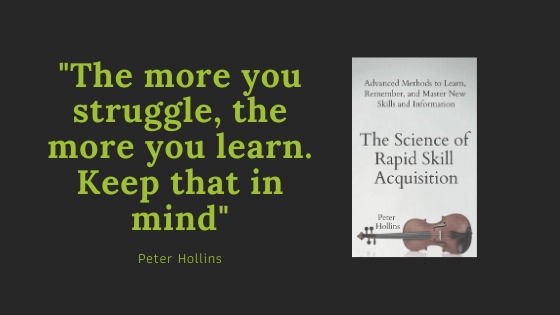Since learning seems to be the recurring theme of the week, I thought I’d try to find a book that speaks to the same idea. And boy did I find it! Peter Hollins’ book, ”The science of rapid skill acquisition” in not only a page turner, but it’s also packed full of practical advice that will help you get reacquainted with learning – and maybe take it to a whole new level.
So how is this book on skill acquisition helpful?
The books is written in a straightforward tone, and each practical tip is accompanied by examples that can help you really see its value. It walks you through the stages of learning – so you can recognise them in your learning, make appropriate decisions, stay real and avoid disappointments.
Then, it walks you through the steps to effective learning, especially the importance of properly planning your learning (including how to choose what you’re learning). It then goes on to discuss the value of practice and the different angles you can approach practice from. It then touches on how to ensure you really understand what you’re learning, and how to make sure your environment (physical space, loved ones etc.) support your learning. The book closes on how to manage your own expectations to ensure you stay on track
My favourite takeaway, though, is his list of questions you can ask yourself to ensure that you make the most of your mistakes. He explains that practice is only effective if it’s hard. In fact, he says, if it’s easy, it’s definitely not doing what you’re hoping it to. “
All the practice in the world won’t do you any good if you aren’t doing it correctly. This is where self-assessment, gaining self-awareness, and learning from your mistakes comes in. It requires brutal honesty, trying to view your blind spots, and going through an assessment of questions that force you to answer, in detail, what you did wrong, and what must be changed going forward. This step cannot be ignored.
Peter Hollins

In order for practice to be effective, you have to engage in some analysis of the mistakes you’re hopefully making by following a set of 10 questions:
- What was the cause of you mistake?
- Did you make a mistake in the strategy or in the method you chose to follow?
- Or did you make a mistake in the execution of your plan?
- What should / could you have done differently?
- Were there any warning signs you missed?
- Did you make any assumptions that turned out wrong?
- Has making this mistake revealed any blind spots or skills you need to practice some more?
- Did this mistake reveal a character trait that’s holding you back?
- How will you do things differently moving forward so this doesn’t happen again?
- If you saw someone else making this mistake, how would you advise them?
In brief, it’s a story of “When you lose, don’t lose the lesson”. If you’re going to make mistakes, which you will, make sure you leverage them to grow. You can see, I think, how this approach will not only help you fix that mistake but also lead to more self-awareness that can prevent other mistakes in the future. How going through this sequence can help you grow as a person and as a professional.
Is the science of rapid skills acquisition for me?
I’m pretty sure it is. If you think that you’re fine – you excelled at learning as a child, so you’ll do just fine, think again. Adults learn differently – and have different needs in their learning. This book is geared towards adults and can help power you learning.
[mks_toggle title=”Book contents” state=”closed”]
1. Learn with rapid skill acquisition
– What to learn?
– Stages of learning
2. Strategic planning
– Under deconstruction
– Mix styles and mediums
– Gather information and resources
3. It’s just practice
– Deliberate practice
– Interleaved practice
– Spaced repetition
– Problem-based learning
– “When you lose, don’t lose the lesson”
– Prioritize it, obviously
4. Deep comprehension
– Elaborative interrogation
– The Feynman technique
– Bloom’s taxonomy
– The curiosity muscle
5. Stack your skills
6. Social and physical surroundings
– No negative Nancys
– Role models, support systems and hotbeds
– Physical surroundings
7. Manage your expectations
– Remain realistic
– What’s the toll?
– Constant confusion
– You know nothing
[/mks_toggle]
Check out my guide on (Re)learning how to learn to take your learning even further.


Leave a Reply